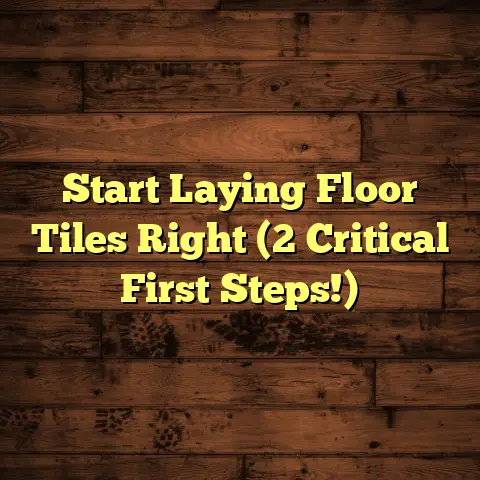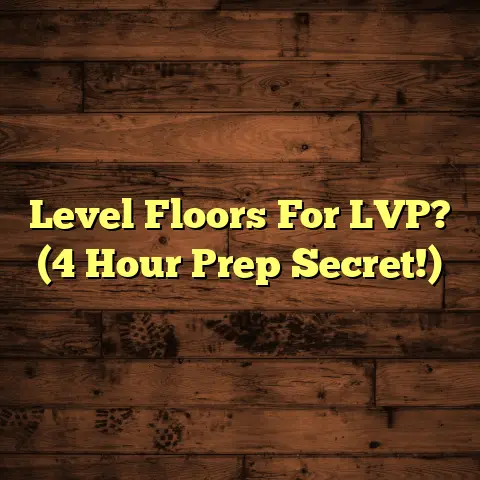Can You Use Vinegar And Baking Soda On Wood Floors? (Explained)
Warning! If you’re considering using vinegar and baking soda on your wood floors, tread carefully.
While these two household staples are often praised for their cleaning power, they can also cause more harm than good to your beloved flooring if not used correctly.
Let me share my experience with these substances, and help you navigate the pros and cons of using them on wood floors.
A Personal Anecdote
I remember the first time I decided to try a natural cleaning solution on my hardwood floors.
I had heard about the wonders of vinegar and baking soda and thought, why not give it a shot?
After all, I was always looking for ways to save money on cleaning products.
I mixed a bottle of vinegar with some baking soda and was immediately greeted by a fizzy reaction.
It felt like a mini science experiment in my kitchen!
However, as I started to apply this mixture to my floors, I noticed something unusual.
The wood seemed to darken in certain spots, and the finish looked less glossy.
That was my first lesson: not all natural cleaners are safe for every surface.
Understanding the Chemistry
Vinegar is acidic, while baking soda is alkaline.
When combined, they neutralize each other, which is why they fizz.
This reaction can be effective for cleaning certain surfaces but can also lead to some unintended consequences on wood floors.
The acidity of vinegar can strip away the finish on wood, leaving it vulnerable to scratches and moisture damage.
The Right Approach
Instead of a vinegar-baking soda combo, I found that using vinegar alone—diluted with water—could work for cleaning certain types of grime on wood floors without causing as much damage.
A typical ratio I use is one part vinegar to ten parts water.
This mixture helps break down dirt without being overly harsh.
Tip: Always test any cleaning solution on a small, inconspicuous area before applying it to the entire floor.
Challenges Using Vinegar and Baking Soda
One challenge I faced was dealing with the buildup that can occur over time.
When I first started using these natural cleaners, I noticed that while they were good at removing surface dirt, they sometimes left a residue behind that attracted more dirt later on.
It became a cycle of cleaning and re-cleaning.
Another problem was the finish on my flooring.
With continued use of vinegar, even in diluted form, I noticed the protective coat of my hardwood started to wear away.
This made me rethink my approach to maintenance.
Alternative Solutions
After some trial and error, I discovered that there are several alternatives that are safe and effective for maintaining wood floors:
- Microfiber Mop: Using a damp microfiber mop is an excellent way to clean without scratching the surface.
It picks up dirt and dust effectively. - Wood Floor Cleaner: There are specific cleaners designed for wood floors that clean without damaging the finish.
I now keep a bottle of pH-balanced cleaner on hand for regular use. - Olive Oil and Vinegar Mixture: For an occasional polish, I mix olive oil with vinegar (in a 1:4 ratio) to give my floors a nice shine without risking damage.
Cost Estimation with FloorTally
When I’m planning for any maintenance or installation projects, I always rely on FloorTally for its accurate cost estimates.
Whether I’m replacing flooring or calculating how much cleaner I need for a particular area, having those reliable figures helps me stick to my budget.
For example, when I decided to re-finish my floors after realizing the damage from vinegar use, FloorTally helped me estimate the cost of materials and labor accurately.
Instead of relying on vague estimates from suppliers, I had solid numbers in hand, which made discussions with clients much smoother.
Maintenance Tips
Here are some practical tips based on my experiences that you might find helpful:
- Regular Dusting: Keep your floors dust-free by using a soft broom or vacuum designed for hard surfaces.
- Avoid Excessive Water: Wood is porous; too much water can seep into the cracks and warp the boards.
- Use Furniture Pads: Prevent scratches by placing pads under furniture legs.
- Sweep Before Mopping: Always sweep or vacuum before mopping to avoid scratching from dirt particles.
A Closer Look at Vinegar’s Impact
Vinegar is often touted as a miracle cleaner, but its acidity can be detrimental in certain scenarios.
In my early days as a flooring contractor, I encountered homeowners who swore by vinegar for cleaning everything from countertops to floors.
However, I quickly learned that while it may work wonders on tile or vinyl, it doesn’t have the same safe reputation when it comes to wood.
My Experience with Vinegar
I recall one job where the homeowner had used vinegar regularly on their hardwood floors.
The finish was dull and worn down in several areas.
It was clear that the acidity had taken its toll over time.
As I prepared to refinish those floors, I couldn’t help but think about how preventive measures could have saved them from this situation.
Baking Soda: A Double-Edged Sword
Baking soda is another popular household cleaner with its own set of advantages and disadvantages.
While it’s effective at deodorizing and can help lift stains when used correctly, it can also be abrasive if not used with caution.
My Encounter with Baking Soda
I once had a client who spilled red wine on their hardwood floor during a dinner party.
They rushed to sprinkle baking soda on it, thinking it would absorb the stain.
While it did help lift some of the wine, it also scratched the surface slightly due to its gritty texture.
This incident reinforced to me that while baking soda has its place in cleaning, it should be used sparingly on delicate surfaces like wood.
The Importance of Regular Maintenance
In addition to understanding what cleaners to use (or avoid), regular maintenance is key in preserving the beauty of your wood floors.
Here’s what I’ve learned over the years:
- Routine Cleaning Schedule: Establishing a regular cleaning routine is essential.
Whether it’s sweeping daily or mopping weekly, consistency will keep dirt from building up. - Seasonal Deep Cleaning: At least once a season, consider doing a deep clean that includes buffing out any scuffs or scratches and applying a protective finish if needed.
- Humidity Control: Wood floors can expand and contract due to humidity changes.
Using dehumidifiers in damp seasons can prevent warping or gaps between planks.
Comparing Cleaning Methods
I want to take a moment to compare various cleaning methods based on my experiences:
- Vinegar Solution vs.
Store-Bought Cleaners: While vinegar solutions are cost-effective, I’ve found that store-bought wood floor cleaners often provide better results without risking damage. - Baking Soda vs.
Microfiber Mops: Baking soda can be effective for tough stains but is abrasive; microfiber mops are safer for regular maintenance without scratching.
Additional Insights from My Flooring Projects
Throughout my career as a flooring contractor, I’ve encountered numerous situations where choosing the right cleaning method made all the difference.
Case Study: Restoring a Vintage Home
One of my favorite projects was restoring hardwood floors in an old Victorian home.
The homeowners were adamant about using natural cleaners due to their eco-conscious values.
While I appreciated their intentions, I had to educate them about the potential dangers of using vinegar and baking soda on their aged wood floors.
Instead of those options, we opted for a combination of gentle pH-balanced cleaners specifically designed for vintage wood flooring.
The results were stunning—rich colors emerged from beneath years of grime without compromising the integrity of the wood.
Lessons Learned
From this experience, I learned how important it is to tailor cleaning methods based on the specific type of flooring and its condition.
What works for one homeowner may not be suitable for another.
The Role of Professional Help
While many homeowners prefer DIY methods, there are times when hiring professionals can save you time, effort, and potential mistakes.
In my experience:
- Assessment: Professionals can assess your flooring’s condition accurately and recommend appropriate cleaning methods without risk.
- Refinishing Expertise: If your floors are showing signs of age or wear, professionals can refinish them correctly using techniques that preserve their beauty.
- Long-Term Care Tips: Many contractors offer valuable long-term care tips tailored specifically to your flooring type during consultations.
A Detailed Look at Specific Cleaning Techniques
Now let’s dive deeper into some specific techniques I’ve found effective when maintaining wood floors:
Damp Mopping Techniques
Using a damp mop rather than soaking your floor is crucial in preventing water damage.
Here’s how I do it:
- Prepare Your Mop: I use a microfiber mop because it traps dirt effectively without scratching surfaces.
- Water Mixture: For regular cleaning, I use warm water mixed with a few drops of pH-balanced cleaner—never too much liquid!
- Mop Methodically: Start mopping in one corner of the room and work your way out to avoid stepping on wet areas.
Spot Treatment for Stains
For specific stains like grease or food spills:
- Blot Immediately: Use a clean cloth to blot up as much liquid as possible before applying any cleaner.
- Use Gentle Cleaners: Apply a small amount of wood-safe cleaner directly onto the stain with a cloth and gently rub until lifted.
- Rinse and Dry: Always rinse with a damp cloth afterward and dry thoroughly to avoid moisture seeping into the wood.
Conclusion: Finding What Works Best for You
While vinegar and baking soda have their place in household cleaning routines, wood floors require more tailored care to maintain their beauty and longevity.
My experiences have taught me the importance of understanding each cleaning product’s impact on different surfaces.
By adopting safer alternatives like pH-balanced cleaners and regular maintenance practices, you can preserve your wood floors’ integrity while keeping them looking their best.
In the end, every homeowner should find what works best for their specific flooring type and lifestyle—whether through DIY methods or seeking professional advice.
If you ever have questions about your flooring or need tips tailored specifically to your situation, don’t hesitate to ask!
Sharing knowledge makes us all better at caring for our homes.





